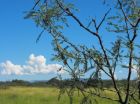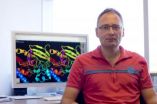(Press-News.org) As the desert Southwest becomes hotter and drier, semi-arid grasslands are slowly being replaced by a landscape dominated by mesquite trees, such as Prosopis velutina, and other woody shrubs, a team of University of Arizona researchers has found.
In a "leaf-to-landscape" approach, the team combined physiological experiments on individual plants and measurements across entire ecosystems to quantify how well grasslands, compared to mesquite trees and woody shrubs, cope with heat and water stress across seasonal precipitation periods.
"Our results show that even the smallest mesquites are better adapted for thriving under elevated temperatures and dry conditions – the projections for our future climate – suggesting that these woody plants are here to stay," said Greg Barron-Gafford, an associate research professor with the UA's Biosphere 2 who led the study, which is published in the scientific journal Global Change Biology.
Over the last century, the face of the Southwest has changed. Before heavy cattle grazing, flowing carpets of grass comprised of, for example, Muhly (Muhlenbergia porteri) or Grama grass (Bouteloua eriopoda) blanketed much of Southern Arizona's open range. Today, woody plants like mesquite trees dominate the landscape.
Native to the region, mesquites have been here for a long time, but not in today's abundance, Barron-Gafford said. "Visitors that see our experimental display at Biosphere 2 are always surprised to hear that the Sonoran Desert in this area used to look very different a century ago."
Scientists have evidence to believe woody plants began displacing grasslands as a result of overgrazing, but has since been propelled by changing climate.
"If there are too many cattle, they have the same effect as a lawn mower," Barron-Gafford said. "They're tilling the soil, and because they don't eat the prickly things, they stay away from the established mesquite trees. But they consume their pods and drop them off in little fertilizer islands. It's a perfect formula for landscape change."
Mesquite trees, the research team discovered, benefit not only from a changing landscape, but also from a climate shifting toward higher temperatures and greater variability in rainfall.
This was surprising, given that, evolutionarily speaking, grasses are better adapted to hot and dry conditions because they use a modified biochemical pathway for photosynthesis, the process by which plants take in carbon dioxide from the atmosphere and convert it into sugars.
"Plants have to open pores in their leaves to breathe in carbon dioxide, and while their pores are open, water diffuses out," Barron-Gafford explained. "Compared to grasses, mesquite trees have to keep their pores open longer for the same amount of sugars they make, meaning they lose more water in the process."
But mesquites overcome their physiological disadvantage with roots that reach down to 160 feet or more; they can tap into groundwater not accessible to plants with shallow root systems.
"Mesquites waste more water, but they can access it much better," Barron-Gafford said. "Their roots are always out there and they find it, allowing them to bypass the grasses' evolutionary advantage. These deep-rooting shrubs and trees are accessing deeper water that was previously unavailable to drive plant biology in this area."
"It levels the playing field," he said. "In the pre-monsoon season in April and May, when the land is very dry and grasses are browning, the mesquites are leafing out. You could say they have their toes dangling in the groundwater pool. In an athletic analogy, it's like some sprinters are already running, while the competition is still getting their shoes on. "
"All of the benefits we associate with these shrubs, such as potentially greater carbon capture from our atmosphere, increased shade, attraction of wild life, and so forth come at the cost of greater water use," he said.
The research aims to improve the models used by climatologists to predict future climate. Current models, said Barron-Gafford, have mostly relied on plant physiology alone. "In an age that will be defined by our management of water resources, it is important to understand the role that this woody plant encroachment has on our regional ecohydrology."
"The known differences in photosynthetic biochemistry have led the scientific community to expect that grasses should be better adapted to a warming climate because they have evolved to be more efficient with less water in higher temperatures and drier conditions."
The new findings reveal that a plant's structure – such as deep roots – plays a more important role in how vegetation adapts to a changing environment than leaf physiology.
His research team used a "portable biosphere" to test how plants perform under different environmental conditions and temperatures. The shoebox-sized device can accommodate a leaf or a branch of a living plant and allows the researchers to seal it off from the environment.
The team made its measurements shortly before, during and after the monsoon in the San Pedro Riparian National Conservation Area in Southeastern Arizona.
"With our portable biosphere we can obtain snapshots of plant activity," Barron-Gafford said. "The device allows us to set and control parameters like temperature, light and relative humidity while we measure the carbon dioxide going in and out of the leaf."
He explained that the dry periods before and after the monsoon are different from each other because once the monsoon rains cease, plant metabolism is still running on high.
"Everything is cranking, except the remaining rain water is now deep underground, and we are measuring at a time when the shallow-rooted plants no longer have that pool to dangle their toes in. That is when the stress comes back for them."
Mesquite trees, on the other hand, were found to be capable of running their photosynthetic metabolism at half their maximum rate regardless of whether it was hot and dry.
"Grasses can only function in a very narrow temperature range," Barron-Gafford said. "While the they are drying out, it's like a hot day by the pool for the mesquite."
"A heavy monsoon downpour saturates the soil, but the surface dries off fast because it's a hot and dry environment," Barron-Gafford said. "But deeper down, the water remains in the soil longer, where the mesquite can access it, but not the grasses. That is a really important implication because our predicted precipitation patterns over the next century are going to favor deeper rooted mesquite shrubs over shallow-rooted grasses."
Because they rely much less on rainfall, mesquites should benefit from the forecasted increasing precipitation variability, offering a possible explanation for the observed encroachment of mesquite plants even in areas no longer subjected to heavy grazing.
To monitor the interactions among plants, water, the soil and the atmosphere on an ecosystem-wide scale, researchers with Biosphere 2 and The U.S. Department of Agriculture operate so-called eddy covariance towers in areas such as the San Pedro River Riparian Area, the Santa Rita Mountains and the Catalina Mountains, which can measure temperature, moisture and gases at defined heights above ground.
"With the towers, we can measure carbon, water and energy flow across an entire ecosystem," Barron-Gafford said.
In addition, his team has transplanted grasses and mesquite saplings into large, highly instrumented drums within Biosphere 2, where the researchers can put the plants through intentional periods of drought and temperature stress. Visitors to Biosphere 2 can see this science in action, right along the tour route, and learn more from members of the research team as they are doing the experiments.
"In the outside world, we actively monitor these leaf and ecosystem level responses to environmental stress, but to truly test the spectrum of responses, sometimes you need more control than nature affords you," Barron-Gafford said.
He said that encroachment of woody plants onto former grasslands exposes the area's semi-arid landscape to a higher risk of irreversible desertification.
"If a fire runs through and burns the thick grass cover that stabilizes the soil, you end up with areas consisting mostly of dirt with mesquite and creosote bushes. The big dust storms in certain parts of Arizona are visual proof how vulnerable that type of landscape is to erosion."
Filling gaps in knowledge about what climate predictions mean for plants and animals in the region and making them accessible to land management officials is an important goal of Barron-Gafford's research. "Our great historical knowledge is not enough given future climate change scenarios and we need biological data in addition to climate data to make accurate predictions."
INFORMATION:
Mesquite trees displacing Southwestern grasslands
Mesquite trees and woody shrubs are better adapted than grasslands to a Southwestern climate predicted to shift toward higher temperatures and greater variability in rainfall, UA ecologists have discovered
2012-03-19
ELSE PRESS RELEASES FROM THIS DATE:
Researchers reveal how a single gene mutation leads to uncontrolled obesity
2012-03-19
Washington, D.C. -- Researchers at Georgetown University Medical Center have revealed how a mutation in a single gene is responsible for the inability of neurons to effectively pass along appetite suppressing signals from the body to the right place in the brain. What results is obesity caused by a voracious appetite.
Their study, published March 18th on Nature Medicine's website, suggests there might be a way to stimulate expression of that gene to treat obesity caused by uncontrolled eating.
The research team specifically found that a mutation in the brain-derived ...
Need for speed
2012-03-19
Like any law-abiding train passenger, a molecule called oskar RNA carries a stamped ticket detailing its destination and form of transport, scientists at the European Molecular Biology Laboratory (EMBL) in Heidelberg, Germany, have found. They show that for this molecule, moving in the right direction isn't enough: speed is of the essence. Their study, published online today in Nature Structural & Molecular Biology, also provides clues as to how a single molecule could receive tickets for different destinations, depending on what type of cell it is in.
For a fruit fly ...
Miami Defense Attorney Diana Gonzalez Runs for Judge
2012-03-19
Ferrer Shane, PL is proud to announce that one of its attorneys, Diana E. Gonzalez, is running for Miami-Dade County Court Judge.
Starting her career in 2004, Diana Gonzalez was rapidly promoted up the ranks in the Public Defender's Office, first handling misdemeanor charges, then defending young people in the juvenile division, to ultimately defending clients charged with the most serious felonies - all in the span of just five years, trying everything from a traffic ticket to a murder case.
Having traveled abroad with the U.S. Department of Defense and with USAID ...
New insight into mechanisms behind autoimmune diseases suggests a potential therapy
2012-03-19
LA JOLLA, Calif., March 18, 2012 – Autoimmune diseases, such as Type I diabetes and rheumatoid arthritis, are caused by an immune system gone haywire, where the body's defense system assaults and destroys healthy tissues. A mutant form of a protein called LYP has been implicated in multiple autoimmune diseases, but the precise molecular pathway involved has been unknown. Now, in a paper published March 18 in Nature Chemical Biology, researchers at Sanford-Burnham Medical Research Institute (Sanford-Burnham) show how the errant form of LYP can disrupt the immune system. ...
UMass Amherst theoretical physicists find a way to simulate strongly correlated fermions
2012-03-19
AMHERST, Mass. – Combining known factors in a new way, theoretical physicists Boris Svistunov and Nikolai Prokof'ev at the University of Massachusetts Amherst, with three alumni of their group, have solved an intractable 50-year-old problem: How to simulate strongly interacting quantum systems to allow accurate predictions of their properties.
It could open the door to practical superconductor applications, as well as to solving difficult "many-body" problems in high-energy physics, condensed matter and ultra-cold atoms.
The theoretical breakthrough by Prokof'ev and ...
Improving Your Doctor's Hygiene
2012-03-19
When people don't feel well, they see a doctor. They probably assume that the doctor will not spread anything to them to make them sicker. Ohio residents may be disturbed to find out that hygiene in hospitals is not as high of a priority as one would expect.
Hospital-acquired infections are the fourth leading cause of death in the United States. A 2004 study done by the American College of Physicians found that only 57 percent of doctors washed their hands when they were supposed to. The study also showed that the busier the doctor was and the more patients needing ...
Columbia Engineering and Penn researchers increase speed of single-molecule measurements
2012-03-19
New York, NY—March 18, 2012—As nanotechnology becomes ever more ubiquitous, researchers are using it to make medical diagnostics smaller, faster, and cheaper, in order to better diagnose diseases, learn more about inherited traits, and more. But as sensors get smaller, measuring them becomes more difficult—there is always a tradeoff between how long any measurement takes to make and how precise it is. And when a signal is very weak, the tradeoff is especially big.
A team of researchers at Columbia Engineering, led by Electrical Engineering Professor Ken Shepard, together ...
A surprising new kind of proton transfer
2012-03-19
When a proton – the bare nucleus of a hydrogen atom – transfers from one molecule to another, or moves within a molecule, the result is a hydrogen bond, in which the proton and another atom like nitrogen or oxygen share electrons. Conventional wisdom has it that proton transfers can only happen using hydrogen bonds as conduits, "proton wires" of hydrogen-bonded networks that can connect and reconnect to alter molecular properties.
Hydrogen bonds are found everywhere in chemistry and biology and are critical in DNA and RNA, where they bond the base pairs that encode genes ...
Genetic variation in East Asians found to explain resistance to cancer drugs
2012-03-19
DURHAM, N.C., AND SINGAPORE – A multi-national research team led by scientists at Duke-NUS Graduate Medical School has identified the reason why some patients fail to respond to some of the most successful cancer drugs.
Tyrosine kinase inhibitor drugs (TKIs) work effectively in most patients to fight certain blood cell cancers, such as chronic myelogenous leukemia (CML), and non-small-cell lung cancers (NSCLC) with mutations in the EGFR gene.
These precisely targeted drugs shut down molecular pathways that keep these cancers flourishing and include TKIs for treating ...
Exotic materials will change optics, Duke researchers say
2012-03-19
DURHAM, N.C. -- Duke University engineers believe that continued advances in creating ever-more exotic and sophisticated man-made materials will greatly improve their ability to control light at will.
The burgeoning use of metamaterials in the field of optics does not rely on the limited set of materials found in nature, but rather man-made constructs that can be designed to control light's many properties. This control is gained by use of metamaterials, which are not so much single substances but entire man-made structures that can be engineered to exhibit properties ...
LAST 30 PRESS RELEASES:
Reviving dormant immunity: Millimeter waves reprogram the immunosuppressive microenvironment to potentiate immunotherapy without obvious side effects
Safety decision-making for autonomous vehicles integrating passenger physiological states by fNIRS
Fires could emit more air pollution than previously estimated
A new way to map how cells choose their fate
Numbers in our sights affect how we perceive space
SIMJ announces global collaborative book project in commemoration of its 75th anniversary
Air pollution exposure and birth weight
Obstructive sleep apnea risk and mental health conditions among older adults
How talking slows eye movements behind the wheel
The Ceramic Society of Japan’s Oxoate Ceramics Research Association launches new international book project
Heart-brain connection: international study reveals the role of the vagus nerve in keeping the heart young
Researchers identify Rb1 as a predictive biomarker for a new therapeutic strategy in some breast cancers
Survey reveals ethical gaps slowing AI adoption in pediatric surgery
Stimulant ADHD medications work differently than thought
AI overestimates how smart people are, according to HSE economists
HSE researchers create genome-wide map of quadruplexes
Scientists boost cell "powerhouses" to burn more calories
Automatic label checking: The missing step in making reliable medical AI
Low daily alcohol intake linked to 50% heightened mouth cancer risk in India
American Meteorological Society announces Rick Spinrad as 2026 President-Elect
Biomass-based carbon capture spotlighted in newly released global climate webinar recording
Illuminating invisible nano pollutants: advanced bioimaging tracks the full journey of emerging nanoscale contaminants in living systems
How does age affect recovery from spinal cord injury?
Novel AI tool offers prognosis for patients with head and neck cancer
Fathers’ microplastic exposure tied to their children’s metabolic problems
Research validates laboratory model for studying high-grade serous ovarian cancer
SIR 2026 delivers transformative breakthroughs in minimally invasive medicine to improve patient care
Stem Cell Reports most downloaded papers of 2025 highlight the breadth and impact of stem cell research
Oxford-led study estimates NHS spends around 3% of its primary and secondary care budget on the health impacts of heat and cold in England
A researcher’s long quest leads to a smart composite breakthrough
[Press-News.org] Mesquite trees displacing Southwestern grasslandsMesquite trees and woody shrubs are better adapted than grasslands to a Southwestern climate predicted to shift toward higher temperatures and greater variability in rainfall, UA ecologists have discovered







